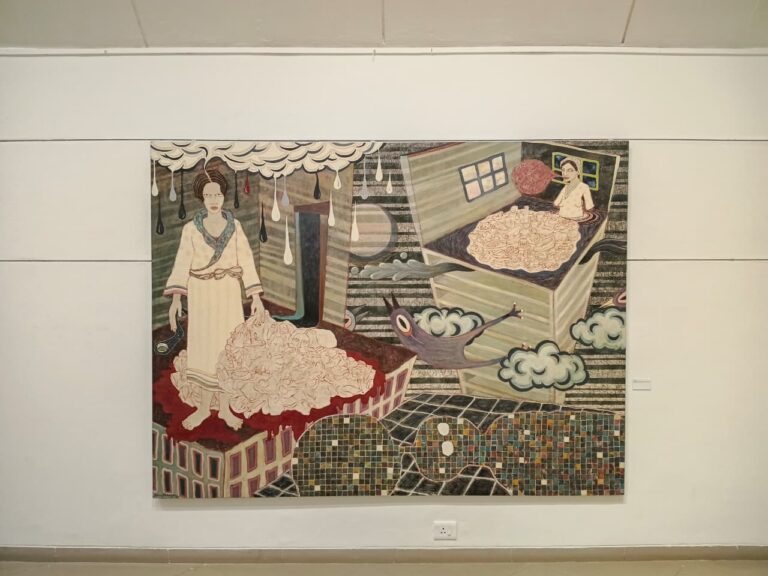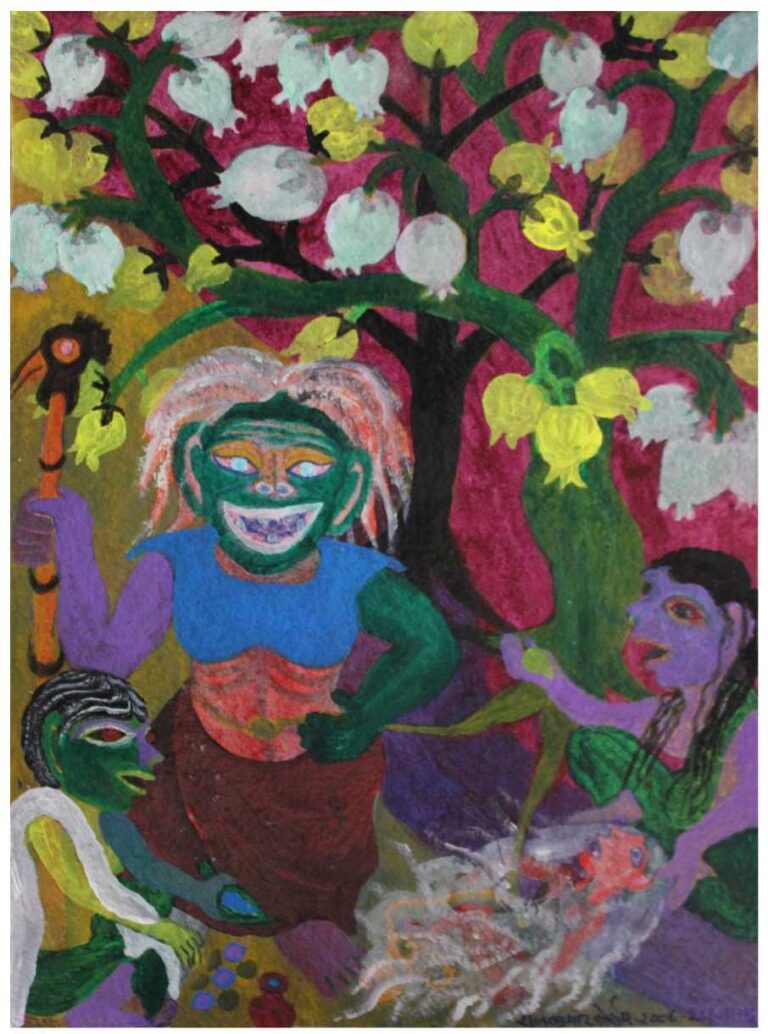At the Curators Hub (2014), Adam Szymczyk spent a brief moment breaking open the originary fragments that form the term ‘curating’. The action verb ‘to curate’, he said was etymologically rooted in the idea of care, derived from the Latin word cura, implying that the curator’s role was care of the art object. This came two years after Susan Hapgood was to refer to the curator as the midwife, only to be further introspected by Aveek Sen hours, later (ECH 2012). Sen’s midwife insert, perhaps formed a fitting afterthought to Szymczyk, “at no point can the midwife call the child his or her own”. Thus, depriving us of the privilege and power that the curatorial job affords us, reducing it to a mere medium, the subordinate, the auxiliary. Between Sen and Szymczyk, lies the thought of the exhibition, as a language, and the curator as the conduit for this language to be performative, active.

The cared object and the birthed or borrowed interpretation of it, allows possibility; a trigger that is mobilised when the audience brings their own “interpretations, histories, emotions” to the object, (Szymczyk, 2014). Yet, increasingly, we see art without materiality, art as process, action, meeting and activity. Art that seeks to help, to change, to have use. Such activities subvert a modernist paradigm for formalism, medium speciality, hyper- individualism and object making. Despite this decline in the production of art objects, the curator’s commitment of care still exists (Nancy Adajania, ECH 2013).
The core to this relationship between a work of art, the processes and the world, would lie perhaps in Shuddhabrata Sengupta’s (ECH 2014) poetry of the “cartography of aesthetic magnetic fields.” Curatorial work as mapping relationships of affinities between objects and processes, that remain distinct until the curator (also the conduit, the midwife, the medium and the subordinate, etc.) discovers, reveals or merely makes apparent the possibilities of their mutual attraction, interaction, tension or opposition. Between this understanding and the time we occupy today, lies the idea of the exhibition as a discursive space– a space of making, unmaking and remaking; learning, educating and sharing; a space to doubt and divide; debate and dismiss and to truly ask “whom is your allegiance to? To the artist? To the organization? Or to the public?” (Ranjit Hoskote, ECH 2014).

Nancy Adajania (ECH 2013) imagines the curatorial site as “a lair to lure the viewer in or perhaps alienate them,” while speaking of devices that made the ninth Gwangju Biennale. The decentralisation of the curatorial position may also be achieved as Adajania proposes, in the re-assignment of the curator as a participant. “Not making a room for the other; but with the other”. Pedro de Almeida (ECH 2017) suggested that “one should never take for granted the commitment of the audience” and Szymczyk spoke of how curators must not infantilise the audience – these are perhaps both important for exhibitions to work as tools of collective learning, as well of unlearning.
The making of the site as an imagination or returning to its historical or its factual position, offers an extended reading to the object, now functioning in the curatorial site; “to rethink the function of fiction in history writing and the task of historiography as one that is highly imaginative” (Natasha Ginwala, ECH 2013). “Traces”, as Sengupta puts it, is all that remains of these sites and we speculate the possibility lies in the return to these historical residues. But alternatively also in the pauses, the arrest of time and a suspended exhibition space, that shakes off the baggage of the historical characteristic and allows the of fiction – the unreal to demonstrate the reality. “History gets interrupted and this is a moment of intervention” as Szymczyk would corroborate.
The site, as Zasha Colah notes, (ECH 2012) inherits a sense of anguish that accompanies spaces of history. In the complication of the past life of the site and the relevance of the exhibition, lies a larger contextual convenience afforded by the visual aesthetics and factual pre-life of the historical site; a giving to the work of art in accidental or intentional curatorial strategy.
In refraining from and reorienting the site to perform imagined, rather than lived histories is where Colah speaks of inhabiting uncertainty –a space of political suspension, reiterating freedoms – “that you don’t know you don’t have,” – individually, curatorially and collectively. Collaborative practices allow for a certain degree of anonymity as we may begin to imagine the collective responsibility of the exhibition and how it operates as a tool in the public sphere using a certain political vocabulary.
Ginwala spoke of the “outsider” while speaking of the Moroccon Artist Mohamed Larbi Rahhali who also lives a lay life (ECH 2016). In doing so, Ginwala also generates the need for constituencies and linguistics for artists that have been otherwise ghettoized or excluded from the majoritarian narratives of art (a case only furthered by Reem Fadda, while talking of West Asian and North African artists in museum collections of the West (ECH 2017). It is a practice that commits itself to counter-hegemonic enterprises giving voice to those who have been left undiscovered, historically silenced, strategically ignored or omitted altogether. These would also be practices that focus for most part on work produced by women, artists of colour, those practicing in the Third World or non-Euro-Americans, and/ or queer and non-binary artists. The irony in the existence of these constituencies perhaps lies in Nada Raza questioning, “Are we really still having to have these tired conversations about Indian subjectivity and the body on the global stage?” (ECH 2017).

Here also lies the question of the ‘other’ institutions embedded in this instance in the global south or more specifically in the geographical segregations of South Asia and West Asia” and the making of a framework, an infrastructure outside of the strictures of the state and its economy. What are the strategies that unmake the conditions of the North American-European iconography and devise truly regional curatorial ecologies and infrastructures for the arts? For Pooja Sood (ECH 2014) the thinking was always in working towards something. “What does it mean to be contemporary in South Asia?” she asks - seeking a relevance for practice that is local and for a language that is intrinsic rather than borrowed from curatorial histories and museum making discourse of the North.
Talking of the frame and picking from Reem Fadda then (ECH 2017), what is essential to eradicate this outsider and insider, marginal and mainstream, North and South, inclusive and exclusive binaries is to challenge frameworks themselves – frameworks that instill works of art with the distance of preciousness and that gate-keep access. For art, to instead open them up, puncture and reclaim these territories, embodies them as we’ve lost so much in compromises and continue to lose some more by the day. In Fadda’s Marrakech Biennale (2016), the focus was on “West Asia and North Africa, the Third World, the Global South, really.” With Not New Now, she questioned modernity’s intentions of being about chasing futures, “you are in a rush to plan your futures, but do you own your current time?”. This obsession with the new she notes, is very anchored on material existences and what becomes absent is living, more so in the negotiations we make in the shadows of our times. “Do we want all our cities to be gated, surveilled?” Instigating a palpable urgency, now is perhaps the time to think about change in a tangible way, almost like an antidote. “I am not worried about being reactive more than I am about being symbolic” Fadda concludes.
The marginal we must acknowledge does not exist only on the periphery. Even those in the vicinity of the art object and the curatorial site of encounter must constantly strive to create accessibility; for only accessibility can perhaps make available the inclusivity promised by the public exhibition. This collective space is where each is reflected by the other, in asking what does it mean to engage in a discourse together?
How do we all become a part of an equation to think people, not objects? (Reem Fadda, ECH 2017). On the issue of authorship, Fadda continues to call out the regimented and hegemonic infrastructures that enforce a way of being, working or learning or curating. This brings us to the problem of institutional narrative and endorsement of a certain historical narrative or political propaganda. “But a singular narrative is no different from propaganda” (Hamad Nassar; ECH 2017) and here is where we must resist and question, “what political responsibility do the frameworks and infrastructures that make art visible and mobile have? Whom does it empower with access and agency and thereby with authority?” (Skye Arundhati Thomas in her closing comments, ECH 2017). In the threat of censorship and the slow severance of freedom, Natasha Ginwala noted that the hub was interested “in the role of curating in a certain public-ness; for curatorial practices to be grounded in openness, iterability and interactivity. The task of curatorial responsibility then more so in today’s epoch is to ask what it takes to negotiate spaces to accommodate collective debate, radical thinking and the shaping of an aesthetics of solidarity” (Natasha Ginwala, ECH 2017).

In a moment of quick reflection at the 2014 Hub, Eungie Joo said “There is no failure in intention, because intention is always about understanding the limitations” and here perhaps lies the reason to try. As most of us working in culture, we must also strive to do something about the impending catastrophe, even if this is too little or too late — we can demonstrate, discuss, disseminate, organize, act. ECH 2017 began on this note. We live in a “highly political and fractured world” noted Prateek Raja, who along with co-director Priyanka Raja envisioned and started the Hub in 2009. Raja flagged the “dramatic transformations and disturbing events” and identified the hub as a small, but potent space of discussing and speaking to this absolute power. The Hub’s close knit allows for an intimacy, an unspoken sense of being in this together, and to collectively make sense and strategise. In other words, we must struggle and persevere together, and that is perhaps what the Curators’ Hub strives to be, to do and will possibly become.














